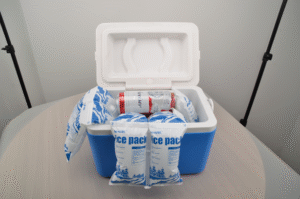When you need dry ice packs for coolers nearby, you’re looking for a safe, reliable way to keep products frozen during transit. This guide covers the essential steps for buying, storing, and shipping with dry ice, y compris 2025 safety regulations and container options for every budget. Whether you’re shipping perishables or medical supplies, you’ll find practical advice backed by industry standards and real-world cases.

-
How do dry ice packs for coolers nearby work to keep products frozen for extended periods?
-
What are the best cooler options for shipping dry ice effectively?
-
How much dry ice do you need for different cooler sizes and distances?
-
How do you label and package shipments to meet 2025 regulatory standards?
-
What storage methods ensure safe handling of dry ice at your location?
What Are Dry Ice Packs for Coolers Nearby?
Dry ice packs for coolers nearby are solid carbon dioxide (Co₂) pellets or blocks packed in a vented insulated container to maintain sub-zero temperatures. Typically used for perishable goods, échantillons médicaux, or ice cream, dry ice ensures the contents remain frozen. Packages using dry ice must be vented, marked “UN1845,” and include the net dry ice mass (kg) to comply with safety regulations like IATA PI 954 et 49 CFR 173.217.
Expanded explanation:
Dry ice sublimates (solid to gas) at -78.5°C, making it an effective coolant. Unlike water ice, it leaves no liquid behind, which is crucial for items that need to remain dry. The primary concern with shipping dry ice is safety: CO₂ can displace oxygen, leading to suffocation or pressure buildup. Donc, containers need to allow gas to escape and must be marked with UN1845 and net kg for air or ground transport.
Are Dry Ice Packs Safe for All Types of Coolers?
Détails:
While dry ice packs can be used with most coolers, the cooler material and the container type significantly affect performance. PSE (Polystyrène élargi) coolers are common for short shipments, while VIP (Panneaux isolés sous vide) provide better thermal performance and reduce dry ice consumption. A cooler designed to handle the venting needs of dry ice will be safer and more effective.
| Cooler Type | Thermal Performance | Dry Ice Impact | Best For |
|---|---|---|---|
| EPS Foam | Moderate | Higher charge | Short hauls (<48 HRS) |
| EPP Crate | Bien | Moderate charge | Durable and reusable |
| VIP | Excellent | Lower charge | Long durations (72HRS) |
Practical Tips for Dry Ice Packs in Coolers
-
Use a divider: Keep dry ice and the product separated to prevent freezer burn.
-
Pack tightly: Ensure the cooler is full to avoid unnecessary air gaps.
-
Ventilation is key: Ensure the cooler has vent holes so CO₂ can escape safely.
Real case: A biopharma company used EPS foam for same-day deliveries and VIP for 48-hour shipments. Dry ice usage decreased by 30% with VIP without compromising product integrity.
How Much Dry Ice Do You Need for Different Coolers?
The amount of dry ice required depends on the cooler size, ambient temperature, and transit time. A general rule of thumb is to use 2–5 kg of dry ice per day per 20L cooler for short transit (24-48 HRS). For longer shipments, VIP containers help reduce the dry ice charge by improving insulation.
Expanded explanation:
You must account for heat leakage over the shipping duration. Cooler walls and ambient temperature affect the rate at which dry ice sublimates. En moyenne, dry ice needs to sublimate ~571 kJ/kg of energy to maintain temperature. Longer shipments (72hrs or more) may require up to 50% more dry ice, depending on the container type and load.
How Do You Pack Dry Ice Packs in Coolers?
Direct answer:
To pack dry ice safely, place it on top of the product in the cooler. Ensure the dry ice is in a vented bag or liner to allow the gas to escape. The cooler lid should not be sealed airtight, and the labels must be visible, showing UN1845 and net kg.
Expanded explanation:
Start by placing a spacer or tray in the bottom of the cooler to separate the product from the dry ice.
-
Add the product into the cooler, and place the dry ice on top (cold air sinks).
-
Seal the cooler loosely and vent it. Ensure there’s no possibility of pressure buildup.
-
Label the cooler properly: UN1845 for dry ice, net kg, shipper/consignee addresses, and Class 9 if necessary.
Labeling & Documentation
-
UN1845: Must be clearly marked on the cooler.
-
Class 9 Hazardous Materials: Label required on all shipments of dry ice (when applicable).
-
Net Mass of Dry Ice: This is required to be marked on both the outer container and the air waybill.
What to Label
| What to Label | Where to Put It | Why It Matters |
|---|---|---|
| UN1845 | On outer carton | Regulatory requirement |
| Class 9 | On outer carton | Hazmat designation |
| Net kg | Outer carton + air waybill | Safety for venting |
How Do You Safely Store Dry Ice Packs?
Dry ice should be stored in a well-ventilated space to allow CO₂ gas to escape safely. Keep dry ice in insulated coolers, but ensure the area is not airtight. Ideally, use vented coolers or allow CO₂ to sublimate in a safe, open area. Store it away from heat sources.
Expanded explanation:
If storing dry ice near your workspace, always ventilate the room and keep it away from confined spaces (Par exemple, closets). Large volumes of dry ice need CO₂ detectors in storage areas, as the gas can displace oxygen, causing suffocation risks. Ensure storage containers are vented and never sealed airtight.
2025 Trends and Updates on Dry Ice for Shipping
Trend overview:
Dans 2025, IATA and DOT will maintain their emphasis on venting dry ice shipments, et 2025 air freight guidelines call for clearer UN1845 labeling. Newer containers, especially VIP (Panneaux isolés sous vide), will gain traction due to their thermal efficiency and ability to reduce dry ice use for long-distance shipments.
Latest Trends at a Glance
-
Carrier job aids: Now more precise in labeling UN1845 and ensuring venting is properly marked.
-
Sustainability focus: More brands are opting for VIP containers to cut CO₂ emissions.
-
Dry ice in e-commerce: Growing use in food delivery and biopharma industries.
Questions fréquemment posées
Q1: How do dry ice packs work to keep products frozen for long durations?
Dry ice sublimates from solid to gas, maintaining sub-zero temperatures and preventing any liquid buildup that could damage items.
Q2: How much dry ice do I need for a 72-hour shipment?
For a 40L cooler, you’ll need approximately 6-7 kg of dry ice, depending on insulation and heat leakage.
Résumé & Recommandations
To ship with dry ice packs for coolers nearby, use vented, insulated containers and ensure proper UN1845 labeling. Always calculate dry ice needs based on your cooler size, route, and heat exposure. Choose VIP containers for long shipments to save on dry ice, and use data loggers to confirm temperature integrity.
Action plan:
-
Pick the right cooler type (PSE, PPE, VIP) based on route length.
-
Estimate dry ice charge with the provided formula and add a buffer.
-
Label clearly with UN1845 + net kg and ensure venting.
À propos du tempk
We specialize in designing dry ice solutions for food, Pharma, and e-commerce businesses. Our team ensures safe packaging, correct venting, and compliance with all 2025 regulations. Clients typically see 25–30% reductions in dry ice costs after we optimize their packouts.
Contact Tempk for expert advice on dry ice packs for coolers nearby and how to meet compliance while reducing costs.























